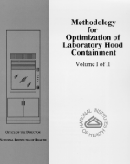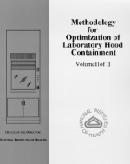
Developing and enforcing national and international standards that ensure high quality facilities
Methodology for Optimization of Laboratory Hood Containment
Page Content
 |
Principal Investigator: Farhad Memarzadeh
Division of Technical Resources
National Institutes of Health
Bethesda, Maryland
November 1996 |
 |
 Executive Summary This research investigates the effect of room air flow on hood containment. It demonstrates that the performance of the hood is strongly dependent on the flow in the laboratory. It is the combination of the parameters that define the resulting flows and which in turn can result in good or bad containment. This document details the work undertaken and its findings, identifying design methodologies that enable the designer to evaluate the likely hood containment performance of proposed designs as well as verifying the performance of current installations either by comparison with the data provided in this document, experimentally, or by simulation for the proposed design. Most importantly, this document provides specific recommendations that can be expected to improve the design in terms of hood containment. These recommendations can be applied alongside current guidelines. The recommendations are included for:
Executive Summary This research investigates the effect of room air flow on hood containment. It demonstrates that the performance of the hood is strongly dependent on the flow in the laboratory. It is the combination of the parameters that define the resulting flows and which in turn can result in good or bad containment. This document details the work undertaken and its findings, identifying design methodologies that enable the designer to evaluate the likely hood containment performance of proposed designs as well as verifying the performance of current installations either by comparison with the data provided in this document, experimentally, or by simulation for the proposed design. Most importantly, this document provides specific recommendations that can be expected to improve the design in terms of hood containment. These recommendations can be applied alongside current guidelines. The recommendations are included for: - hood position in the laboratory - side wall, end wall, corner;
- physical separation between working hoods:
- on the same wall,
- on opposite walls,
- on perpendicular walls;
- the use of a bulkhead above the hood;
- diffuser position in relation to the hood:
- alignment,
- separation;
- makeup air from adjacent spaces - transfer grilles vs. door cracks;
- diffuser blanking of individual jets to protect the hood;
Many other parameters such as supply air temperature, diffuser type, and ventilation rate are also considered so that a comparison can be made of alternative proposals. This will allow designers and planners to evaluate and improve their own proposed configurations.
This document also provides details of a measurement procedure that can be used to verify the performance of existing laboratory hood installations.
This page was last updated on Nov 27, 2012